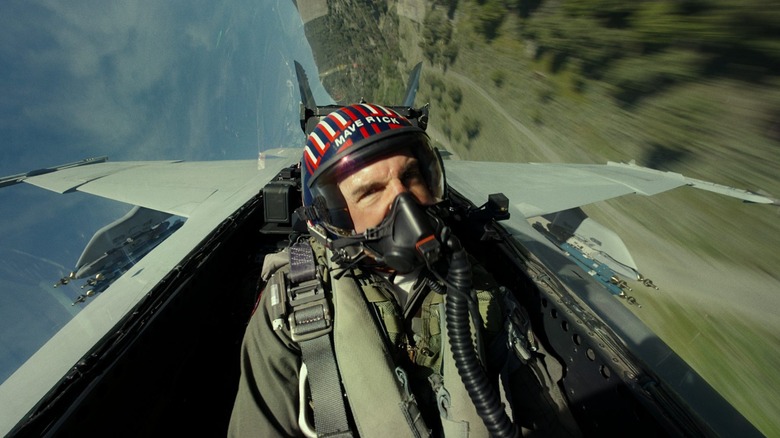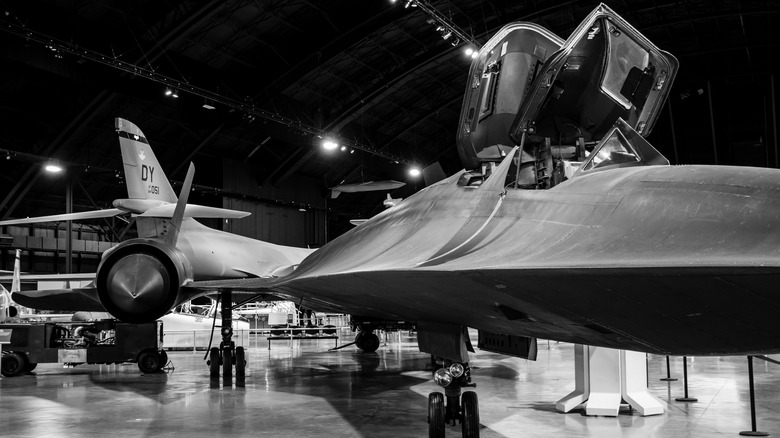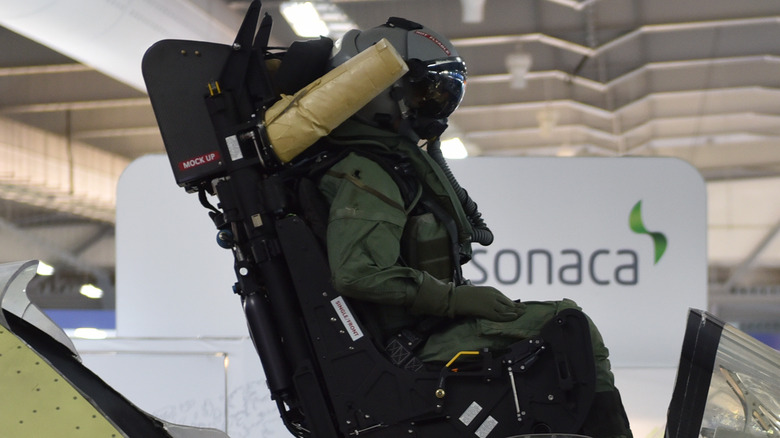What Would Really Happen If You Ejected At Mach 10
Fans of "Top Gun: Maverick" may recall a scene where the title character, played by Tom Cruise, decides to push a prototype Darkstar hypersonic jet a bit too far and is forced to eject when it starts to come apart. Maverick made it through the ordeal completely unscathed, which you could put down to Hollywood bending the laws of reality to avoid killing off a title character early on in a movie. But is there a chance you could eject from a plane at ten times the speed of sound and live to tell the tale? Astrophysicist and presenter Neil DeGrasse Tyson doesn't seem to think so, having tweeted "At that air speed [sic], his body would splatter like a chainmail glove swatting a worm. Just sayin'."
Late to the party here, but In this year’s @TopGunMovie, @TomCruise’s character Maverick ejects from a hypersonic plane at Mach 10.5, before it crashed.
He survived with no injuries.
At that air speed, his body would splatter like a chainmail glove swatting a worm. Just sayin’. pic.twitter.com/YP9IKVc8VS
— Neil deGrasse Tyson (@neiltyson) October 9, 2022
But is there a chance Tyson is wrong, and a real-life Maverick could make it? As you can imagine, the situation is quite complex. The first hurdle is strapping into a jet capable of doing that incredible speed in the first place. While the SR-72 Cruise pushed past Mach 10 was made up for the movie, it is still somewhat based in reality. Its foundations lie with one of the fastest vehicles ever built — Lockheed's SR-71 Blackbird.
Does the U.S. Air Force have a Mach-10 Jet?
Let's just get this out of the way. You can't eject from an aircraft at Mach 10 without first being in an aircraft that is traveling at Mach 10. A U.S. Air Force pilot is highly unlikely to find himself in such a scenario because the United States military doesn't have an aircraft capable of traveling at those speeds. Nor does any other military — at least not one that has been publicly acknowledged. The fastest military plane, and fastest production aircraft, currently in service is still the Lockheed SR-71 "Blackbird" which is capable of climbing to a height of 85,000 feet and traveling at a speed of 2,200 miles per hour — or just over Mach 3. According to NASA, the Blackbird was first developed in the 1960s as a reconnaissance aircraft.
The Blackbird also had an ejection system. That system was used at Mach 3 when a sharp turn coupled with some system malfunctions caused the plane to break apart at 78,000 feet. And one of the men relying on it, Bill Weaver, survived to tell the tale. The man Weaver was flying with, Lockheed flight test reconnaissance and navigation systems specialist Jim Zwayer, wasn't so lucky. At some point during the accident, which lasted around three seconds, Zwayer's neck was broken, and he was killed instantly. Weaver didn't exactly eject either, he was actually ripped from the disintegrating aircraft by the massive positive and negative G-forces both testers were subjected to during the accident. Shortly before it all went wrong, Weaver noticed something was up and tried to get the jet to a lower altitude so he and Zwayer could bail conventionally.
How do you survive a supersonic ejection?
According to ChuckYeager.org, Weaver didn't have a lot of faith in the Blackbird's ejection system, but some very clever technology did manage to save his life. Even Lockheed, who had knowledge of the circumstances surrounding the crash, believed nobody could have survived the accident. The huge G-forces didn't kill Weaver, but they did render him unconscious and the test pilot initially believed he was dead and experiencing the afterlife as he came to during the descent.
Ejecting at extremely high speed and altitude isn't like taking a parachute jump. There are a number of factors that could kill a human long before the 16-mile fall gets its chance. G-forces are an issue, but it's possible for a human to survive over 46 Gs in extremely small bursts. Sustained G-force is a different issue, with fighter pilots requiring specialized suits to stop all of their blood from being forced down to their feet when they reach 9 Gs. According to Medical Daily, a minute at 10 Gs would be enough to kill a person not wearing special gear.
The test pilot who survived the Blackbird crash was wearing a specialized suit, which provided oxygen so he wouldn't suffocate, and also used the attached oxygen tank to pressurize the suit as a whole and negate the chances of his blood boiling in the low atmospheric pressure. The pressure in the suit also provides some protection from the G-forces Weaver encountered and the freezing temperatures you get up where the air is thin. Low pressure also means there's no resistance to stop someone tumbling at high speed, which could again cause injury or death, so the ejection system included a stabilizing chute, and the main chute deployed at 15,000 feet, bringing him safely back to earth.
There are other ejection methods
There's another ejection method that might keep a person safe when escaping a plane at high speed, high altitude, or in other dangerous conditions. It's also pretty obvious when you think about it. Ejection pods aren't much bigger than standard ejection seats, but will totally encapsulate a person before jettisoning them from the aircraft. The inside of the pod is pressurized, the hard shell protects the person inside from things like debris, and things like flailing limbs aren't an issue — though crew members with bigger feet may lose their toes when the pod snaps shut.
The pods were originally designed for the B-58A Hustler, a supersonic bomber capable of hitting speeds above Mach 2. While the pods would usually be closed just before a crew needed to bail out, they could also be used in other circumstances. If the cabin lost pressure, crew members could close the pods and still maintain limited control of the plane. Each capsule contained a small window allowing the person inside to see what was going on beyond their safety pod, and there were also features like a control stick meaning pilots could still fly the plane right up until they actually ejected. If the pod was closed, but the situation had been resolved before anyone actually had to eject, it could be re-opened using a lever near the passenger's feet, and the flight could resume normally. Like other ejector seats, the pods had parachutes that would automatically deploy and a built-in survival kit to keep everyone going until a rescue mission could be mounted.
It's not the ejection part that's the problem
If you simply ejected at Mach 10 using a regular jet's ejection system, or even a pressure suit, you would not survive. But it's not the ejection part that would cause an issue and, contrary to what Neil deGrasse Tyson said, you're unlikely to "splatter like a chainmail glove swatting a worm." As former NASA astronaut and U.S. Navy Captain Scott Kelly explains in a tweet, the altitude you'd need to reach those speeds would actually work in your favor. The pressure at sea level would tear you to pieces at those speeds, but the extremely thin atmosphere at which a Mach 10 hypersonic jet is operating wouldn't rip you and your suit to pieces or decelerate you so quickly that your organs would smash into your skeleton and basically turn your body into a bag of soup. So you may survive the ejection, but getting back to earth is a different matter.
To be completely clear. At the altitude at which a Mach 10 hypersonic aircraft would be flying, the ejection would be very survivable, the reentry into the atmosphere in just a pressure suit, not so much.
— Scott Kelly (@StationCDRKelly) October 10, 2022
At the altitude the jet would be traveling at, you'd basically have to re-enter the atmosphere to get back to ground level. This essentially creates the same problems space shuttles are designed to survive, such as the heat generated from re-entry. In a suit like the one that saved Bill Weaver, or in a standard ejector seat, you'd probably be burned to a crisp.
So is an ejection at Mach 10 survivable?
In a specialized ejection capsule designed to survive that exact situation, you would more than likely be fine as long as the capsule didn't malfunction. People have also survived dropping from the edge of space in special suits. Felix Baumgartner set a world record in 2012 when he plummeted from close to 128,000 feet, breaking the sound barrier on his descent. Alan Eustice, a pilot and former Google executive, went on to break that record, again in a specially designed suit.
The suits both space jumpers wore may not be practical for piloting an advanced aircraft and were essentially designed to keep someone alive while they clung to a large balloon and then dropped to earth from an incredible altitude. Piloting a plane in one of the specialized suits is, at best impractical and, at worst impossible. Even if you could comfortably fly a plane in one, the suit itself surviving the rigors of ejection and still being in a condition where it could get you back to earth in one piece is another matter. Jumping from a balloon and bailing out at hypersonic speeds are two different things.
However, between those suits and concepts like ejection capsules, the technology is there to ensure a real-life Maverick has a good chance of coming home in one piece if he ever runs into trouble at ten times the speed of sound.



